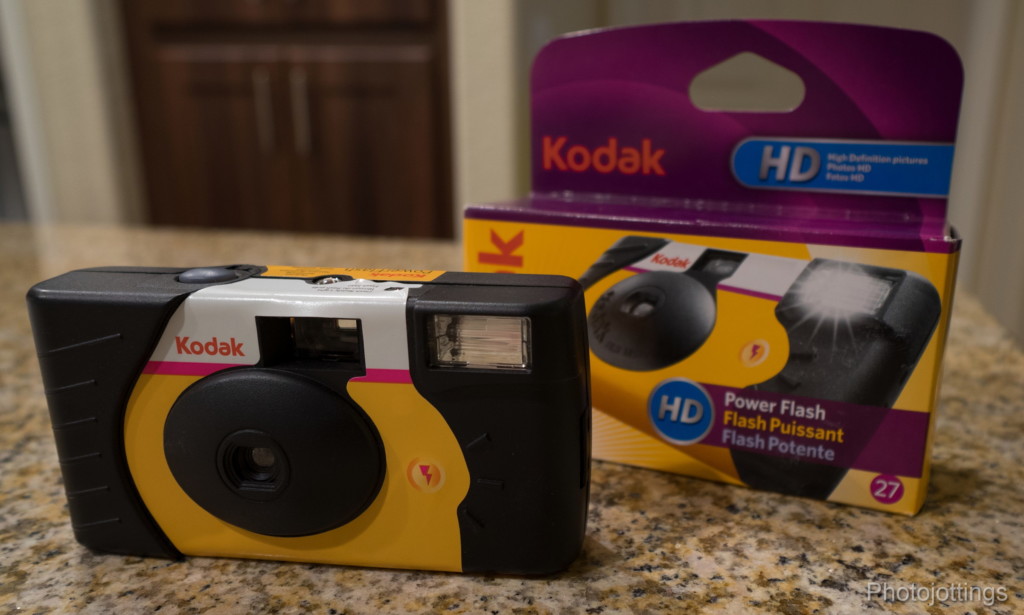
Our review camera today is the Kodak HD power flash single use camera (B&H Photo, Ebay, Amazon) which comes loaded with Max 800 film. This is a fun snapshot camera where you fire away without worries, as there are no controls other than to wind the film and turn on the flash if necessary. It’s also very small and lightweight, and will fit in a shirt pocket!
Cost; between $6 and $9 depending on whether you buy a single camera, or a multi pack.
Comes in a cardboard box, camera is sealed in a foil wrapper, no instructions but it does have a battery for the flash.
Lens: looks like a fixed focus two element plastic lens, and uses a curved film gate for further corrections, see picture below. Approximate focal length, between 25-28mm, approximate fixed aperture; F/16. Fixed shutter speed averages about 1/100 sec, see speed test picture.
Flash recharge time is lengthy, around 15 seconds between shots, but has a pretty good output with a range from 4′-14.5′ (1.2m-4.5m).
My own approximate dimensions; 4.55″ (110mm) long, 2.35″ (60mm) tall, 1.45″ (37mm) deep including lens protrusion. Weight is 3.5 oz (99g).
Number of exposures: Kodak uses their Max 800 film which is marketing by itself as 24 exposures, but loading in a darkroom as they do when making the camera yields 27 images. You can get 27 images on any roll of 24 as long as you can load the camera yourself in the dark and do not have to advance it to the first shot mark; however, with motorized auto loading cameras, you probably won’t get any more than 25.
Re-using the camera. It is possible to re-load the film and reset the exposure counter. First off, do not hand over the camera to your developer, otherwise they’ll take out the film and throw the camera away, or turn it in for recycling. Make sure you advance the film all the way to the end, usually the counter says ‘e’ or ‘0’ and the winder wheel starts turning easily with no tension. Take out the film yourself by opening the film door at the bottom of the camera, or on the right side as you hold the camera to your face, it depends on the model. The door may be hidden with a sticker, so slice or peel away the sticker and pry out the door using a screwdriver or other appropriate object. Before you plop in a new roll of film, you’ll need to modify the film canister to work with the winder. Good lord, don’t wast your time doing this.
I wouldn’t bother re-loading film for this camera unless you just like to screw with things and have a bunch of time. Note: the camera has a battery which powers the flash, so be careful when messing with the inside, as people claim they get shocked by stored voltage from the flash.
Get a camera from ebay for the same price as this one that will accept different film, or one that is about the same size but with much better photo quality.
Here are some test pictures from negatives scanned using the Nikon Coolscan 9000. As I said in the introduction, the focal length is pretty wide, however, Kodak, Fuji and other developers and printers based in drugstores usually cropped the image, so the actual image area would be more in the neighborhood of 30-32mm. I’m guessing they did this do avoid some of the mushy areas along the sides of the images, which is normal for really cheap lenses. The first sample pic, Desert Saguaro at 1600 pixels wide, is about as good as you get from this camera, larger images do not show more detail. The centers are pretty sharp, but the sides are soft, and that goes for all the images. The picture named ‘house cropped to square format’ is part of a Real Estate shoot I did using this camera, and the Realtor loved it. The last image shows a different home interior using the flash; I think the Kodak single use camera takes better pictures than the average cell phone in low light. One area that really sucks with the simple plastic lens is flare control, well, it doesn’t have any; pictures with bright sun directly shining into the lens are mostly ruined by massive contrast loss and streaks, however, you could use this creatively I suppose.
All things considered, the Kodak single use camera is fun, and puts out decent photo quality, especially if you scan the negatives yourself with a good dedicated film scanner. If you rely on your local developer/printer, you will probably not get anything close to what you see here, the reason being they scan the negatives too quickly, and that results in a poor light range from deep shadows to bright skies; plus, the colors are not really accurate/punchy in my opinion. But then again, this is a fun camera, right? and if the images look crappy, so what, you had fun just taking the pictures!

















